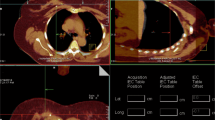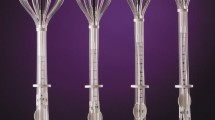Abstract
Background
Patients with early-stage breast cancer can benefit from adjuvant accelerated partial breast irradiation (APBI) following breast-conserving surgery (BCS). This work reports on cosmetic results following APBI using multicatheter high-dose-rate interstitial brachytherapy (HDR-IBT).
Patients and methods
Between 2006 and 2014, 114 patients received adjuvant APBI using multicatheter HDR-IBT. For each patient, two photographs were analyzed: the first was taken after surgery (baseline image) and the second at the last follow-up visit. Cosmesis was assessed by a multigender multidisciplinary team using the Harvard Breast Cosmesis Scale. Dose–volume histogram (DVH) parameters and the observed cosmetic results were investigated for potential correlations.
Results
The median follow-up period was 3.5 years (range 0.6–8.5 years). The final cosmetic scores were 30% excellent, 52% good, 14.5% fair, and 3.5% poor. Comparing the baseline and follow-up photographs, 59.6% of patients had the same score, 36% had a better final score, and 4.4% had a worse final score. Only lower target dose nonuniformity ratio (DNR) values (0.3 vs. 0.26; p = 0.009) were significantly associated with improved cosmetic outcome vs. same/worse cosmesis.
Conclusion
APBI using multicatheter HDR-IBT adjuvant to BCS results in favorable final cosmesis. Deterioration in breast cosmesis occurs in less than 5% of patients. The final breast cosmetic outcome in patients treated with BCS and APBI using multicatheter HDR-IBT is influenced primarily by the cosmetic result of the surgery. A lower DNR value is significantly associated with a better cosmetic outcome.
Zusammenfassung
Einleitung
Brustkrebspatientinnen im Frühstadium können nach einer brusterhaltenden Operation (BCS) von einer adjuvanten akzelerierten Teilbrustbestrahlung (APBI) profitieren. Die vorliegende Arbeit berichtet über die kosmetischen Ergebnisse nach APBI mittels HDR-interstitieller Brachytherapie (HDR-IBT) in Multikatheter-Technik.
Methoden
Zwischen2006 und 2014 hatten 114 Patientinnen eine adjuvante APBI mittels Mulitkatheter-HDR-IBT erhalten. Von jeder Patientin wurden 2 Fotografien analysiert: die erste wurde nach der Operation, aber vor Implantation der Brachytherapiekatheter (Basisbild) aufgenommen, die zweite bei der letzten Nachuntersuchung. Die kosmetische Bewertung wurde durch ein multidisziplinäres Multigender-Team anhand der „Harvard-Breast-Cosmesis“-Skala bewertet. Dosis-Volumen-Histogramm-(DVH-)Parameter und die beobachteten kosmetischen Veränderungen wurden auf mögliche Korrelationen untersucht.
Ergebnisse
Die mediane Nachbeobachtungszeit betrug 3,5 Jahre (Spanne 0,6–8,5 Jahre). Die endgültige kosmetische Bewertung war bei 30 % ausgezeichnet, bei 52 % gut, bei 14,5 % fair und bei 3,5 % schlecht. Ein Vergleich der Basis- und Nachsorge-Bilder ergab bei 59,6% keine Veränderung, bei 36% ein besseres und bei 4,4 % ein schlechteres Ergebnis. Nur niedrigere ‚‚Dose-non-uniformity-ratio‛‛-(DNR-)Werte (0,3 vs. 0,26; p = 0,009) waren signifikant mit einem verbesserten kosmetischen Ergebnis assoziiert.
Schlussfolgerung
APBI mittels HDR-IBT ergibt ein günstiges endgültiges kosmetisches Ergebnis. Eine Verschlechterung der Kosmetik der Brust tritt bei weniger als 5 % der Patientinnen ein. Die endgültigen kosmetischen Ergebnisse bei mit BCS und HDR-IBT behandelten Patientinnen werden vor allem durch das kosmetische Ergebnis der Operation beeinflusst.

Similar content being viewed by others
References
Fisher B, Anderson S, Bryant J et al (2002) Twenty-year follow-up of a randomized trial comparing total mastectomy, lumpectomy, and lumpectomy plus irradiation for the treatment of invasive breast cancer. N Engl J Med 347:1233–1241. doi:10.1056/NEJMoa022152
Litière S, Werutsky G, Fentiman IS et al (2012) Breast conserving therapy versus mastectomy for stage I‑II breast cancer: 20 year follow-up of the EORTC 10801 phase 3 randomised trial. Lancet Oncol 13:412–419. doi:10.1016/S1470-2045(12)70042-6
Darby S, McGale P, Correa C et al (2011) Effect of radiotherapy after breast-conserving surgery on 10-year recurrence and 15-year breast cancer death: meta-analysis of individual patient data for 10,801 women in 17 randomised trials. Lancet 378:1707–1716. doi:10.1016/S0140-6736(11)61629-2
Cox JA, Swanson TA (2013) Current modalities of accelerated partial breast irradiation. Nat Rev Clin Oncol 10:344–356. doi:10.1038/nrclinonc.2013.65
Mózsa E, Mészáros N, Major T et al (2014) Accelerated partial breast irradiation with external beam three-dimensional conformal radiotherapy. Five-year results of a prospective phase II clinical study. Strahlenther Onkol 190:444–450. doi:10.1007/s00066-014-0633-1
Kimple RJ, Klauber-DeMore N, Kuzmiak CM et al (2011) Cosmetic outcomes for accelerated partial breast irradiation before surgical excision of early-stage breast cancer using single-dose intraoperative radiotherapy. Int J Radiat Oncol Biol Phys 79:400–407. doi:10.1016/j.ijrobp.2009.10.032
Struikmans H, Snijders M, Mast ME et al (2016) Single dose IOERT versus whole breast irradiation: Cosmetic results in breast-conserving therapy. Strahlenther Onkol. doi:10.1007/s00066-016-1029-1
Strnad V, Sauer R, Niehoff P (2013) Evaluation of (balloon) brachytherapy for partial breast irradiation in breast cancer based on current meta-analyses. Strahlenther Onkol 189:899–901. doi:10.1007/s00066-013-0425-z
Polgár C, Major T, Fodor J et al (2010) Accelerated partial-breast irradiation using high-dose-rate interstitial brachytherapy: 12-year update of a prospective clinical study. Radiother Oncol 94:274–279. doi:10.1016/j.radonc.2010.01.019
Strnad V, Hildebrandt G, Pötter R et al (2011) Accelerated partial breast irradiation: 5‑year results of the German-Austrian multicenter phase II trial using interstitial multicatheter brachytherapy alone after breast-conserving surgery. Int J Radiat Oncol Biol Phys 80:17–24. doi:10.1016/j.ijrobp.2010.01.020
Vaidya JS, Wenz F, Bulsara M et al (2014) Risk-adapted targeted intraoperative radiotherapy versus whole-breast radiotherapy for breast cancer: 5‑year results for local control and overall survival from the TARGIT-A randomised trial. Lancet 383:603–613. doi:10.1016/S0140-6736(13)61950-9
Khan AJ, Arthur D, Vicini F et al (2012) Six-year analysis of treatment-related toxicities in patients treated with accelerated partial breast irradiation on the American Society of Breast Surgeons MammoSite Breast Brachytherapy registry trial. Ann Surg Oncol 19:1477–1483. doi:10.1245/s10434-011-2133-1
Offersen BV, Overgaard M, Kroman N, Overgaard J (2009) Accelerated partial breast irradiation as part of breast conserving therapy of early breast carcinoma: a systematic review. Radiother Oncol 90:1–13. doi:10.1016/j.radonc.2008.08.005
Njeh CF, Saunders MW, Langton CM (2012) Accelerated partial breast irradiation using external beam conformal radiation therapy: a review. Crit Rev Oncol Hematol 81:1–20. doi:10.1016/j.critrevonc.2011.01.011
Veronesi U, Orecchia R, Maisonneuve P et al (2013) Intraoperative radiotherapy versus external radiotherapy for early breast cancer (ELIOT): a randomised controlled equivalence trial. Lancet Oncol 14:1269–1277. doi:10.1016/S1470-2045(13)70497-2
Krug D (2016) Accelerated partial breast irradiation using interstitial multicatheter brachytherapy: A valid treatment option for breast cancer patients with a low-risk profile? Strahlenther Onkol 192:127–129. doi:10.1007/s00066-015-0932-1
Strnad V, Ott OJ, Hildebrandt G et al (2016) 5‑year results of accelerated partial breast irradiation using sole interstitial multicatheter brachytherapy versus whole-breast irradiation with boost after breast-conserving surgery for low-risk invasive and in-situ carcinoma of the female breast: a randomised, phase 3, non-inferiority trial. Lancet 387:229–238. doi:10.1016/S0140-6736(15)00471-7
Kuske RR, Winter K, Arthur DW et al (2006) Phase II trial of brachytherapy alone after lumpectomy for select breast cancer: Toxicity analysis of RTOG 95-17. Int J Radiat Oncol 65:45–51. doi:10.1016/j.ijrobp.2005.11.027
Rabinovitch R, Winter K, Kuske R et al (2014) RTOG 95-17, a Phase II trial to evaluate brachytherapy as the sole method of radiation therapy for Stage I and II breast carcinoma-year-5 toxicity and cosmesis. Brachytherapy 13:17–22. doi:10.1016/j.brachy.2013.08.002
Harris JR, Levene MB, Svensson G, Hellman S (1979) Analysis of cosmetic results following primary radiation therapy for stages I and II carcinoma of the breast. Int J Radiat Oncol Biol Phys 5:257–261
Roth A‑M, Kauer-Dorner D, Resch A et al (2014) Is oncoplastic surgery a contraindication for accelerated partial breast radiation using the interstitial multicatheter brachytherapy method? Brachytherapy 13:394–399. doi:10.1016/j.brachy.2013.09.003
Strnad V, Hannoun-Levi J‑M, Guinot J‑L et al (2015) Recommendations from GEC ESTRO Breast Cancer Working Group (I): Target definition and target delineation for accelerated or boost Partial Breast Irradiation using multicatheter interstitial brachytherapy after breast conserving closed cavity surgery. Radiother Oncol 115:342–348. doi:10.1016/j.radonc.2015.06.010
Cox JD, Stetz J, Pajak TF (1995) Toxicity criteria of the Radiation Therapy Oncology Group (RTOG) and the European Organization for Research and Treatment of Cancer (EORTC). Int J Radiat Oncol Biol Phys 31:1341–1346. doi:10.1016/0360-3016(95)00060-C
Pavy JJ, Denekamp J, Letschert J et al (1995) EORTC Late Effects Working Group. Late effects toxicity scoring: the SOMA scale. Radiother Oncol 35:11–15
Polgár C, Fodor J, Major T et al (2013) Breast-conserving therapy with partial or whole breast irradiation: Ten-year results of the Budapest randomized trial. Radiother Oncol 108:197–202. doi:10.1016/j.radonc.2013.05.008
Hannoun-Levi JM, Resch A, Gal J et al (2013) Accelerated partial breast irradiation with interstitial brachytherapy as second conservative treatment for ipsilateral breast tumour recurrence: Multicentric study of the GEC-ESTRO Breast Cancer Working Group. Radiother Oncol 108:226–231. doi:10.1016/j.radonc.2013.03.026
Polgár C, Major T, Fodor J et al (2004) High-dose-rate brachytherapy alone versus whole breast radiotherapy with or without tumor bed boost after breast-conserving surgery: seven-year results of a comparative study. Int J Radiat Oncol Biol Phys 60:1173–1181. doi:10.1016/j.ijrobp.2004.05.012
Hepel JT (2014) Late toxicity and cosmetic outcomes related to interstitial multicatheter brachytherapy for partial breast irradiation. Brachytherapy 13:23–26. doi:10.1016/j.brachy.2013.09.001
Chen PY, Vicini FA, Benitez P et al (2006) Long-term cosmetic results and toxicity after accelerated partial-breast irradiation: a method of radiation delivery by interstitial brachytherapy for the treatment of early-stage breast carcinoma. Cancer 106:991–999. doi:10.1002/cncr.21681
Genebes C, Chand M‑E, Gal J et al (2014) Accelerated partial breast irradiation in the elderly: 5‑year results of high-dose rate multi-catheter brachytherapy. Radiat Oncol 9:115. doi:10.1186/1748-717X-9-115
Olivotto IA, Whelan TJ, Parpia S et al (2013) Interim cosmetic and toxicity results from RAPID: A randomized trial of accelerated partial breast irradiation using three-dimensional conformal external beam radiation therapy. J Clin Oncol 31:4038–4045. doi:10.1200/JCO.2013.50.5511
Wazer DE, Kaufman S, Cuttino L et al (2006) Accelerated partial breast irradiation: an analysis of variables associated with late toxicity and long-term cosmetic outcome after high-dose-rate interstitial brachytherapy. Int J Radiat Oncol Biol Phys 64:489–495. doi:10.1016/j.ijrobp.2005.06.028
Cardoso MJ, Cardoso JS, Vrieling C et al (2012) Recommendations for the aesthetic evaluation of breast cancer conservative treatment. Breast Cancer Res Treat 135:629–637. doi:10.1007/s10549-012-1978-8
Arthur DW, Koo D, Zwicker RD et al (2003) Partial breast brachytherapy after lumpectomy: Low-dose-rate and high-dose-rate experience. Int J Radiat Oncol 56:681–689. doi:10.1016/S0360-3016(03)00120-2
Trombetta M, Julian TB, Kim Y et al (2012) Mature follow-up of Low-dose rate interstitial brachytherapy following ipsilateral breast tumor recurrence in patients initially treated with breast conservation therapy. J Solid Tumors 2:8–15. doi:10.5430/jst.v2n1p8
Shah S, Holzwanger E, Khwaja R et al (2015) A single-site retrospective, nonrandomized study of accelerated partial breast irradiation brachytherapy for early-stage breast cancer treatment to evaluate local tumor control, cosmetic outcome, and toxicities. Technol Cancer Res Treat. doi:10.1177/1533034615595724
Niehoff P, Warm M (2015) Akzelerierte Teilbrustbestrahlung mit interstitieller Brachytherapie. Strahlenther Onkol 191:757–758. doi:10.1007/s00066-015-0870-y
Author information
Authors and Affiliations
Corresponding author
Ethics declarations
Conflict of interest
T. Soror, G. Kovács, N. Seibold, C. Melchert, K. Baumann, E. Wenzel, and S. Stojanovic-Rundic declare that they have no competing interests.
Ethical standards
All procedures performed in studies involving human participants were in accordance with the ethical standards of the institutional and/or national research committee and with the 1964 Helsinki declaration and its later amendments or comparable ethical standards. Informed consent was obtained from all individual participants included in the study. Consent was obtained from all patients identifiable from images or other information within the manuscript. In the case of underage patients, consent was obtained from a parent or legal guardian.
Rights and permissions
About this article
Cite this article
Soror, T., Kovács, G., Seibold, N. et al. Cosmetic changes following surgery and accelerated partial breast irradiation using HDR interstitial brachytherapy. Strahlenther Onkol 193, 367–374 (2017). https://doi.org/10.1007/s00066-016-1093-6
Received:
Accepted:
Published:
Issue Date:
DOI: https://doi.org/10.1007/s00066-016-1093-6




